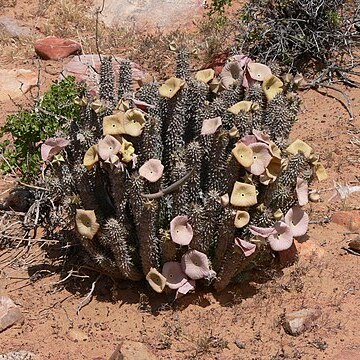Spiny, glabrous, succulent shrub, up to 1 m tall, stems leafless, 25-50 mm diam., greyish, 11-17-angled, with stout spines 6-12 mm long. Flowers 1-4, in sessile, subterminal clusters, pedicels 8-30 mm long. Corolla rotate, 40-100 mm diam., inside flesh-coloured and smooth to papillate, tube 1-1.5 mm deep, lobes up to 15 x 50 mm, ovate with subulate point. Corona purple-black, outer lobes cupular, inner lobes 1 mm long.
Perennial shrub, 0.5-1.0 m high. Stems succulent, cylindrical, 25-50 mm thick with 11-17 distinct ribs; greyish green to brown. Leaves rudimentary. Flowers: inflorescence shortly pedunculate, 1-4-flowered; corona ± one tenth of corolla diameter; corolla 40-100 mm wide, rotate, flat, clearly 5-lobed, flesh-coloured becoming deep purple to red towards centre; Jan.-Dec. Fruit a follicle.
A succulent herb or shrub. It grows about 80 cm high. The stems are 305 cm thick. The flowers are star shaped or bell shaped. They are 1-17 cm across. They are dull brown colour and have a bad smell like rotten meat. This attracts flies to pollinate the plant.
Spiny, cactus-like, leafless succulent to 1 m, with 11-17-angled stems; sap clear. Flowers 40-100 mm diam., flesh-coloured, somewhat foul-smelling.

